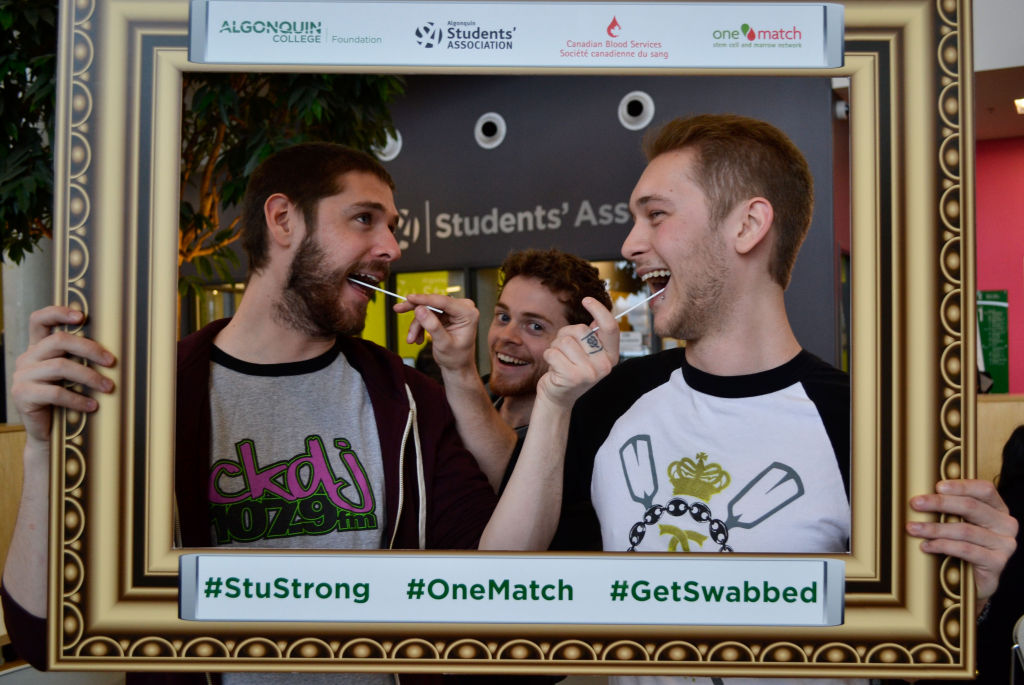
In partnership with Canadian Blood Services’ One Match Stem Cell and Marrow Network, the AC Foundation hosted #GetSwabbed in Student Commons April 11.
The event was held to help increase students’ awareness about the importance of blood and bone marrow donation, and to honour “Stuntman” Stu Schwartz, who is an Algonquin alumnus and popular radio host for Majic 100. He is now receiving treatment for Leukemia after being diagnosed in February.
“He’s done a lot and given back quite a bit to the Algonquin community and when we found out that he was sick we decided that we wanted to do something to support him and to honour him,” said Liz Ellwood, manager of Fundraising and Communications for the AC Foundation.
“When we found out we could do a One Match event on campus we thought that would be a good way to show our support and allegiance to him and other cancer patients and to maybe help some people who are waiting for matches.”
The event resulted in an impressive turnout, with many students and faculty members from various departments coming out to show their support for Schwartz and for stem cell transplants by voluntarily getting swabbed.
“[Schwartz] has been a great support to me at various moments throughout my career and you know it was really deeply emotional but also touching the way he announced that he had leukemia, (and) the fight he’s put up against it as well has been really inspirational to see,” said Phil Gaudreau, Algonquin’s Communications Officer for Public Relations and Communications.
“He’s somebody who means so much to this community and I think it’s important we’re giving back to him in the same way that he’s given to us.”
Others agreed.
“I figured, might as well get swabbed and see if I could help out a fellow alumni, Stu Schwartz, ‘Stuntman Stu’ and then maybe someone else out there,” said Dylan Cole, a second-year Radio Broadcasting student. “So yeah I’m really hoping to maybe match up with someone and if I can, help someone out.”
The swabbing process took about 10 minutes to complete per person and involved donors first filling out registration forms, then inserting a long swab in their mouths and gently scraping the inside of their cheeks to collect skin cells. This method is done to help determine each registrant’s HLA typing – the unique code which is used to match patients with donors for stem cell transplants.
Schwartz is currently in leukemia remission, which means the number of leukemic cells in his blood system are below a certain per cent and that his physical examinations, blood counts, and bone marrow fluids show no detectable traces of leukemia. Schwartz is still undergoing chemotherapy at the Ottawa Hospital in order to prevent the cancer from returning.
The next and final step for Schwartz will be to receive a bone marrow stem cell transplant.
However finding a donor is a fairly challenging process. Less than 25 per cent of patients on the transplant list will find a match within their own family or other relatives. Well over three-quarters of patients needing a transplant will have to rely on the generosity of unrelated donors.
“The chances of finding a match are slim to none, even with millions of people on the registry it’s very difficult to find even one match for a patient,” said Jessica Stergiou, a One Match spokesperson and the coordinator of Donor Management for Canadian Blood Services.
Stergiou said that among donors, young males in good health are preferred as ongoing research has shown their stem cells offer an improved post-transplant outcome for patients. As well, young male stem cells tend to have a reduced incidence of producing Graft vs. Host Disease in patients. A patient also has the best chance of finding a match in a donor within his or her own ethnic group.
Stergiou said that she strongly encourages all those who couldn’t attend the event to visit www.blood.ca to register as a stem cell donor to help save a life like Stuntman Stu’s as well as many others currently awaiting a match on the stem cell transplant list.


